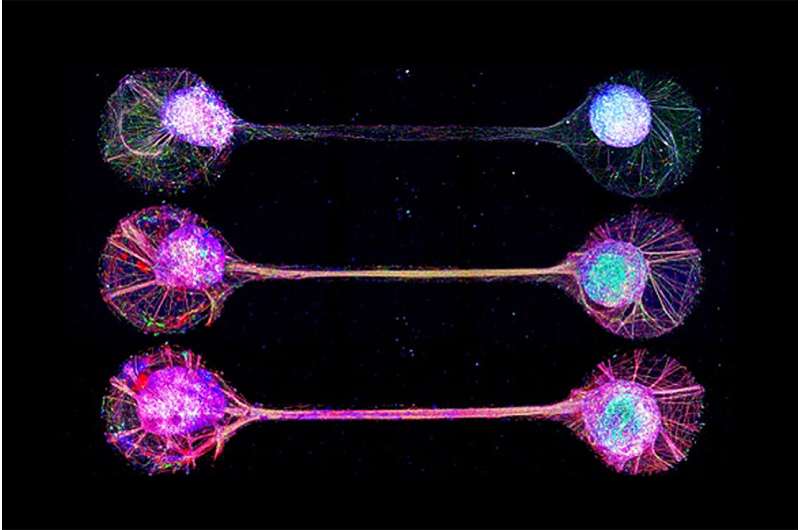
Researchers from the Institute of Industrial Science, The University of Tokyo, find that providing lab-grown ‘cerebral organoids’ with connections similar to those in real brains enhances their development and activity. Credit: Institute of Industrial Science, The University of Tokyo
The idea of growing functioning human brain-like tissues in a dish has always sounded far-fetched, even to researchers in the field. Towards the future goal, a Japanese and French research team has developed a technique for connecting lab-grown brain-mimicking tissue in a way that resembles circuits in our brain.
The work appears in Nature Communications.
It is challenging to study exact mechanisms of the brain development and functions. Animal studies are limited by differences between species in brain structure and function, and brain cells grown in the lab tend to lack the characteristic connections of cells in the human brain. What’s more, researchers are increasingly realizing that these interregional connections, and the circuits that they create, are important for many of the brain functions that define us as humans.
Previous studies have tried to create brain circuits under laboratory conditions, which have been advancing the field. Researchers from the University of Tokyo have recently found a way to create more physiological connections between lab-grown “neural organoids,” an experimental model tissue in which human stem cells are grown into three-dimensional developmental brain-mimicking structures. The team did this by linking the organoids via axonal bundles, which is similar to how regions are connected in the living human brain.
“In single-neural organoids grown under laboratory conditions, the cells start to display relatively simple electrical activity,” says co-lead author of the study Tomoya Duenki. “When we connected two neural organoids with axonal bundles, we were able to see how these bidirectional connections contributed to generating and synchronizing activity patterns between the organoids, showing some similarity to connections between two regions within the brain.”
The cerebral organoids that were connected with axonal bundles showed more complex activity than single organoids or those connected using previous techniques. In addition, when the research team stimulated the axonal bundles using a technique known as optogenetics, the organoid activity was altered accordingly and the organoids were affected by these changes for some time, in a process known as plasticity.
“These findings suggest that axonal bundle connections are important for developing complex networks,” explains Yoshiho Ikeuchi, senior author of the study. “Notably, complex brain networks are responsible for many profound functions, such as language, attention, and emotion.”
Given that alterations in brain networks have been associated with various neurological and psychiatric conditions, a better understanding of brain networks is important. The ability to study lab-grown human neural circuits will improve our knowledge of how these networks form and change over time in different situations, and may lead to improved treatments for these conditions.
More information:
Complex Activity and Short-Term Plasticity of Human Cerebral Organoids Reciprocally Connected with Axons, Nature Communications (2024). DOI: 10.1038/s41467-024-46787-7
Citation:
Connecting lab-grown brain cells provides insight into how our own brains work (2024, April 10)
retrieved 10 April 2024
from https://medicalxpress.com/news/2024-04-lab-grown-brain-cells-insight.html
This document is subject to copyright. Apart from any fair dealing for the purpose of private study or research, no
part may be reproduced without the written permission. The content is provided for information purposes only.
>>> Read full article>>>
Copyright for syndicated content belongs to the linked Source : Medical Xpress – https://medicalxpress.com/news/2024-04-lab-grown-brain-cells-insight.html































